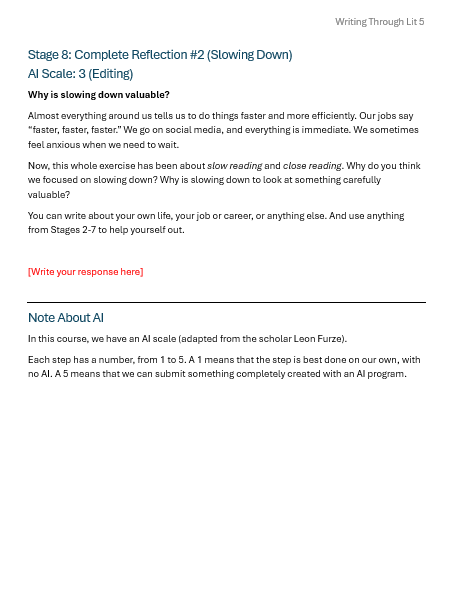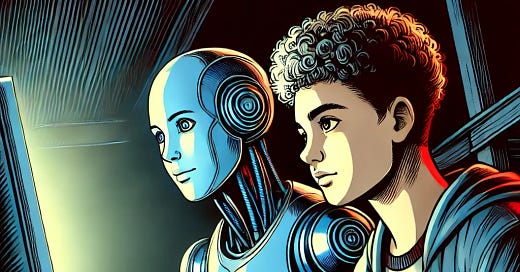Goodbye, Papers. Hello, AI-Powered Portfolios!
I just junked my students' final paper assignments and did something different. Here's what I did, how I did it, and why.
Last week, I had an existential crisis.
I’ve been writing about AI and and education for almost two years. I’ve shared AI products that seem especially useful, as well as ideas for AI-infused assignments and discussion topics.
But last week, I looked at my Final Essay topics for my foundational Literature course.
Imposter Syndrome hit hard.
For context, here are the Final Essay Topics I was assigning:


The topics felt very traditional.
Looking at them, I felt like a fraud.
I’ll be honest. I’ve been doing micro-experiments for years. I’ve been using AI to selectively boost engagement and to improve assignments. I worked it into my my writing courses in small doses.
I had not reimagined assessment yet.
Below is the new assignment. ⬇️







Click Here to See It All In a Google Doc
Basically, instead of completing a traditional paper, my students will:
Download a Word Doc.
Go through each stage and put in their answers for any of the red font.
Freewriting
Close Reading
Listing Takeaways (Synthesizing)
Talking with a Contrarian Chatbot
Writing a 3-Paragraph Position Statement
Reflecting on How They Might Improve
Reflecting on the Value of Slowing Down
Then, they submit the resulting Portfolio as their Final Project.
Now that you have the before and after, let’s go over how I moved from Essay Assignments to AI-Powered Portfolios.
How I Did It
The entire rewrite stemmed from a single idea.
I needed to focus more on the core skills I wanted my students to practice than on the product. Instead of focusing on “knowing how to write a paper,” I was shooting for much bigger game: thinking critically, analyzing closely and carefully, synthesizing evidence.
Those skills could be pivotal to writing a paper. But not necessarily. So many of my students knew the essay form so well that they could fake those skills within that context.
So, what could I do to make it more difficult to fake competency? What could I do to make it easier to give substantive feedback on the process, rather than the product?
That, in truth, is where this all came from.
Once I identified that (which took some time), things started to fall into place.
Step #1 was to frontload ambiguity. My students’ first impulse, when writing a paper, is to search for clarity. They want a thesis statement. Then, they’ll just organize from there. And that approach makes sense: my students want to be efficient.
For this exercise to be helpful, I needed to throw a wrench in the process. I need to slow things down.
That’s why I started off with free writing and close reading.
I wanted them to take 5 minutes to just get their ideas down (these should be messy and have a lot of human error). The goal here is to get their ideas on the paper: the good, the bad, and the ugly.
Quantity over quality.
That first step is important. I’m trying to give my students a playground for kicking around ideas, before they even engage with AI. This helps make the following steps human-centered rather than technology-centered.
Once my students have put their assumptions and general ideas into written form, we’re ready to start poking at those assumptions and ideas. I send them back to the text, so that they can select a passage and mark it up. Eventually, that markup leads to its own idea.
This is where I want to use AI—to complement their discovery rather than to supplant it.
I ask my students to engage with a Contrarian Bot, which I had designed specifically for this purpose.
(Full Disclosure: You might not find this bot useful, because it’s designed for a particular context and for a particular audience. It’s not copy-and-paste friendly.)
That Contrarian Bot nudges them, poking holes at the assumptions and ideas they’ve already written about. It tries to change their minds about something related to the story.
Once the student finishes talking with the Contrarian Bot, they copy and paste the link to the entire chat onto the Portfolio Sheet. This allows me to grade the chat, not the paper, as
would say.That chat becomes a source that students can use later on. When they move onto the Short Position Statement (about 3 paragraphs), they can use that specific chat to help them out.
The last 2 stages focus on Reflection. I ask them to first reflect on what they would have done differently if they had unlimited time. Then, I ask them to reflect on the social implications of close reading: why is it valuable (for work and life) to slow down when our society encourages us to go faster and faster.
All along the way, I used
’s AI Scale (where he gives a 1 for No AI use and a 5 for full-on AI use) to make the expectations clear.I’ve designed the essay to help boost students’ abilities to:
Debate
Read Carefully
Communicate clearly and directly
Think About their Thinking (Metacognition)
It’s really not necessary for me to assign a paper to assess these skills. In fact, sometimes assigning a traditional paper gets in the way.
Why I Did It
Process over product.
There’s something so comforting about grading a single paper.
So the story goes, reading the paper gives us immediate access to students’ thought process. Reading the paper shows us how they think.
It’s nice. But a lot of the time, it’s not true.
We are seriously limited if we focus only on a product, especially if our students have generated hundreds of those kinds of products in the past.
My students know how to fake the essay form, even if they haven’t done any of the reading, close analysis, or thinking.
The goal, with this reworking of the assignment, is to make it more difficult to fake the process. That way, I can jump in and help.
It’s not just about preserving the essay. It’s about making the process of learning and thinking visible.
The Takeaways
This is far from perfect.
Within the next couple of weeks, I’ll get my first AI-Powered Portfolios, and I’ll go from there.
But here are my big lingering questions:
How can I give my students more autonomy over this process?
Would including videos for the reflection portion improve the Portfolio?
How might I work in multimodal work? Would that improve the learning process?
Some Great People Working On AI & Assessment
The following people, in my mind, are some of the best people thinking about assessment in The Age of AI.
(Sorry for anyone I missed!)
Leon Furze: His AI Scale is so useful, as a student-facing tool that gives them a sense of how AI might be used.
Michelle Kassorla: She’s done great work on incorporating AI use into her grading rubrics
- : His “Stop Grading Essays, Start Grading Chats” framework is phenomenally helpful.
- : He has a great method for making AI misuse more difficult, while optimizing how students are using AI. (Unlike Furze’s tool, this one is more teacher-facing than student-facing.)
Phillip Alcock: He argues for AI-assisted Project-Based Learning as a path forward.
I’d definitely recommend checking them out!




This protocol is ambitious, Jason. I think I would classify it as a curriculum embedded constructed response task. Generally, portfolios ask students to select artifacts from their ongoing work and write about them to point to features of their work that provide evidence of learning in their eyes. What if you did this. Give the students free access to the bot—they decide if, when, and how they use it. The task? Think about the six stories read in class. Rank order them according to how much you “like” the story. Focusing on the top two and the bottom two stories, write an essay pointing out the things you appreciate about the top two and the specific details that made you place the bottom two stories at the bottom. Note: This doesn’t have to mean you “dislike” them. Suggestion: Use the bot to help you generate some criteria you can apply to short stories help you talk those you like a lot and those you like not so much. You will have 40 minutes to complete this task. For a third of your grade, write a post task analysis responding to each question: 1. What problems did you face as you worked on this task? What did you do to solve them? 2) How did you use AI to support your work? How do you feel about these uses? 3) What did you learn about judging short stories? What questions remain for you?
Thanks for sharing this! I'm a writing professor, so I can't entirely junk paper assignments (or else I'll be violating our program policy), but I like what you're doing here in terms of process over product. One question, though: how do you handle students who want to opt out of using AI at all? At my institution we're not allowed to require the use of AI for any assignment (and I agree with this approach, in terms of my own ethics), and so have to have an alternate but equivalent assignment for those who don't use AI (so in essence, I have to create two versions of every assignment and activity, whee!). I didn't see any alternate options in your Google Doc so I'm curious if you actually do require your students to interact with the AI? Do you get any pushback?